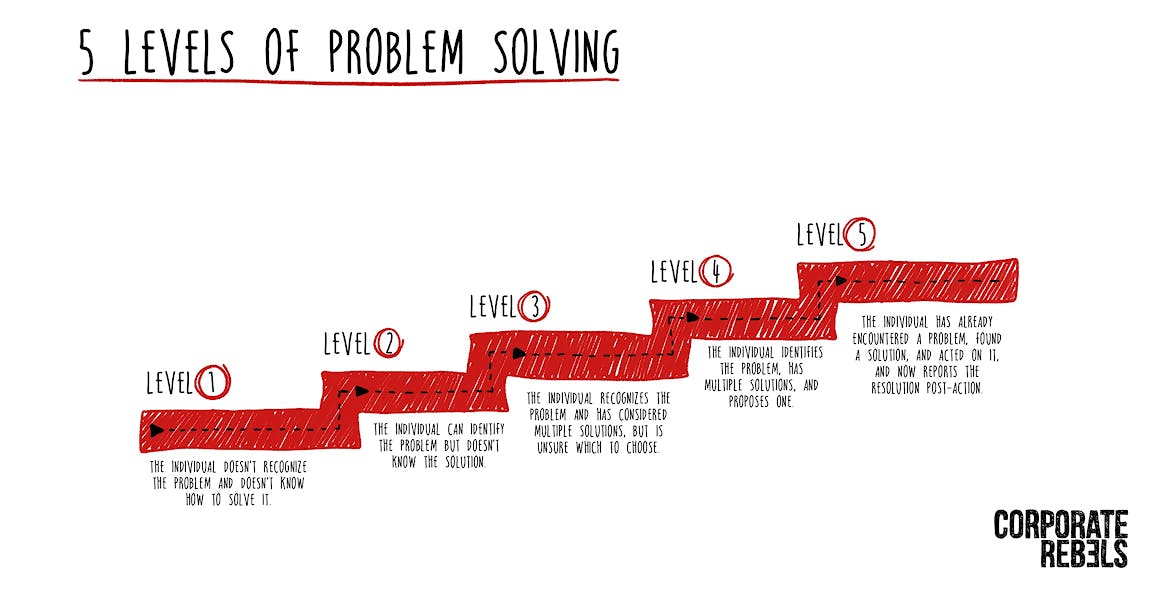5 Levels Of Problem Solving: A Framework For (First-Time) Managers

Leading people can be tough. Taking the reins for the first time? It can feel like navigating a maze blindfolded. Many first-time managers feel that pit in their stomach. Without the right guidance or training, they often turn, unintentionally, into micromanagers. Nobody's dream scenario. But, good news - help's at hand!
A few weeks ago, I interviewed two workplace pioneers for one of our monthly live events (part of the Corporate Rebels Academy). In this extremely insightful conversation, I had the pleasure of interviewing Edwin Jansen and Luz Iglesias. They both work at Raise (formerly known as Ian Martin Group).
The company employs over 450 people and has offices in the US, Canada, India, Ghana, and the Philippines. It is a certified B Corp and has been reinventing its management practices for about 8 years.
Its business? Recruitment.
Avoid becoming the all-mighty fixer
In 2017, Edwin and Luz took the lead on changing the company's way of working. They started in one of the company's subsidiaries and used it as a test ground for finding a better way to work.
When I asked Edwin, who was the leader of the subsidiary back then, what their biggest challenge was, his answer was clear:
"It was me. I had to change."
Edwin: "At the time, Luz pointed out a significant flaw in my approach: I had become a 'fixer'. To be clear, this wasn't a compliment.
"It highlighted a dangerous trajectory where I had become the go-to person for every problem, failing to empower my team members to think critically and solve issues independently.
"Doing so, I robbed people of the opportunity to learn and grow."
In a self-managing organization, leaders have to let go and give others the opportunity to step up. Edwin was very honest about his shortcomings:
"I simply didn't know how to do that. I had to let people find their own solutions, support them to take more ownership, and stop solving their problems for them."
Edwin and Luz decided to change.
5 levels of problem solving
Along the way, Edwin encountered a framework that helped him become a better leader.
The framework details 5 levels of problem solving - moving from highly dependent to highly independent. The clarity of the various 'levels' of problem solving helped him and his colleagues to create awareness on how they were operating, while also providing clear opportunities for growth (for all involved).
Here's how Edwin explained it:
To summarize, here are the 5 levels Edwin talked about:
- Level 1: The individual doesn't recognize the problem and doesn't know how to solve it.
- Level 2: The individual can identify the problem but doesn't know the solution.
- Level 3: The individual recognizes the problem and has considered multiple solutions, but is unsure which to choose.
- Level 4: The individual identifies the problem, has multiple solutions, and proposes one.
- Level 5: The individual has already encountered a problem, found a solution, and acted on it, and now reports the resolution post-action.
Wanna improve? Here's Edwin's advice:
"At any point, if you're a manager and someone comes to you, whatever level they come to you at, ask them to go one level up.
"And if you're not a manager and you're coming with problems, make sure you're at the highest level that you possibly can be."
Solid (and practical) advice.

Start decentralizing decision-making now
Decision-making is an art, but with the right framework, it becomes a systematic process that fosters growth and innovation.
The '5 levels of problem solving' is one of those frameworks that has the power to change the way you work immediately. Print it out, share it with your team, and follow Edwin's advice.
Eager for more tips, tools, and frameworks to improve your decision-making? We've got you covered.
With an in-depth course, lots of pioneering practices, and powerful tools, our Academy has everything you need to radically reinvent the way you work.
Start now. Click here.




